Bad Credit Current Accounts
Bad Credit Current Accounts
Having a current account is one of the building blocks of personal finance management – but if you have a bad credit history, you could find it a struggle to get a even a basic current account with a high street bank.
However, several providers offer current accounts specifically designed for people with a bad credit rating. These types of accounts won’t usually carry out credit checks, so they can be a good option for people whose credit rating is damaged due to previous missed payments, CCJs, or bankruptcy.
Use the table to compare some of the latest bad credit rating current accounts, or click on the links to apply online.
There are some alternatives to current accounts that people with bad credit may benefit from considering. If you are unable to find a bank that allows you to open a current account, you may want to consider the other options shown in the table below. Remember to shop around and consider all of your options before making your final decision. Some of the advantage of a bad credit current account can include:
- No credit checks – open to most UK residents aged 18 and over
- Set up direct debits and standing orders
- No overdraft means no unexpected charges
- Use your prepaid card like a normal debit or credit card to withdraw cash or make online purchases
- Get your wages paid directly into the account
- 24/7 online account management
- An account manager to help you keep track of your spending and improve your credit rating
What if there are any problems?
And the switching service is covered by a guarantee: the new bank must refund you if there are any charges because payments didn’t go through on time. But you have to ask them for this.
Can I keep my old current account open when I switch?
What about transferring “recurring payments”?
Because they’re linked to a card rather than directly to your bank account, they’re not included in the switching service (or covered by the guarantee).
It’s not always clear which are your continuous payment authorities: you won’t find them listed on your online banking portal. When you set them up you were asked for you card details (“please read me the long card number”) rather than your bank account and sort code numbers.
You’ll need to check your monthly card statements: any regular payments going out each month that are not marked as DD (direct debit) or SO (standing order) are likely to be continuous payment authorities.
If you want to keep paying for this service (or loan) in this way, you’ll need to contact each provider and tell them your new card details as soon as you have them.
This may sound like a lot of bother, but it is useful to check periodically what’s going out of your account regularly: there may be services you’re not using (such as fast delivery, or additional online data storage) that you want to cancel.
What about the individuals who have my bank account details, for sending occasional payments?
It’s probably not a good idea to just email all your Contacts with your new account details. If you’re concerned about email security, the most secure way of sending bank account details to specific people is via WhatsApp.
And if any payments are accidentally made to your old account, for 36 months (three years) after you’ve switched, your new bank or building society will arrange for any payments to be automatically redirected to your new account. They will also contact the sender and give them your new account details.
When should I choose to make the transfer?
If all your regular payments tend to go out of your account around the same time it’s best to choose a time of the month when your bank account isn’t so busy.


